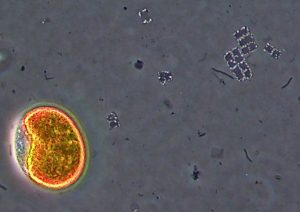This micrograph shows a sample taken on 2 April 2025 from salt pans near the Mar Menor (Murcia, Spain), a haven of extremophile diversity. On the left is the alga Dunaliella salina that has lost its two characteristic flagella and is in the process of encysting. Blooms of these microalgae give the brine waters their orange and red hues. When the brines become more concentrated, the abundance of hyperhalophilic bacteria and Archaea changes the water colour to pink.

At top right and centre, with bright spots (gas vacuoles under phase contrast), individual cells and colonies that resemble old-fashioned sheets of postage stamps correspond to the fascinating square archaeon Haloquadratum walsbyi. An empty square dead cell (a ‘ghost’) of this archaeon can just be seen in the lower right of the micrograph. Other hyperhalophilic prokaryotic flexuous bacilli, probably Salinibacter sp., are also visible in the microscopic field. Samples and images were taken by Prof Francisco Torrella of the Universidad de Murcia, one of our valued international advisors.
Prof Torrella comments: “The adaptations of the various organisms to that environment are written in their genomes but some can already be seen in the different shapes, colours and structural details of the cells. Isolation of the organisms is an important part of the story, of course, but understanding the autecology and specific strategies they use to colonise such an extreme habitat is also a challenging task for the dedicated scientist”.
EBNet agrees: we have barely begun to appreciate the variety and diversity of individual microbes and microbial communities, for their own sake or as a potential component in Environmental Biotechnology. This theme is echoed in the Microbes in wastewater treatment animation. As the final sentence says, “The journey to understanding them is just beginning”!


